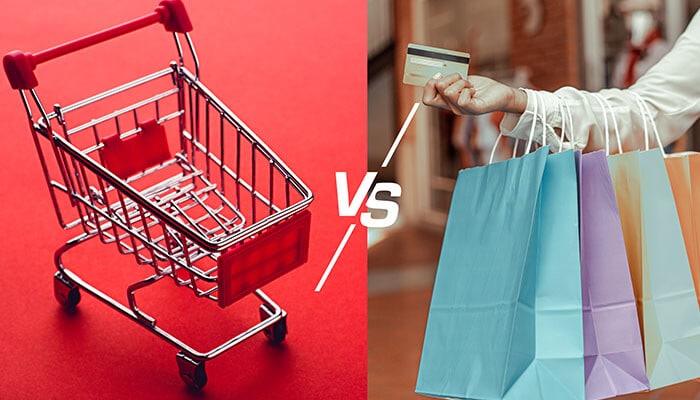Not all product sales follow the same rules. Some businesses rely on physical locations, shelves, walk-in traffic, etc. Others operate entirely online and reach customers through screens and shipping boxes. The difference is more than just format. It’s a shift in business logic. Retail vs e-commerce may sell similar products. But how they sell, scale, and survive are completely different conversations. Understanding retail and ecommerce difference helps avoid expensive mistakes, especially when launching or pivoting a business.
Core Business Logic Behind Retail and E-commerce Models
At the core, retail means selling in a physical location. A store, a stall, a showroom. Customers browse, interact with products, and pay on-site. Inventory is stored locally. Revenue depends on foot traffic, location, and in-person service.
E-commerce operates through websites, apps, or platforms, without physical contact. Customers view images, read descriptions, evaluate goods, and place orders online. Payments, logistics, customer service happen digitally.
Both models involve products and buyers. But the systems behind them are built differently.
1. Retail relies on local presence. You rent a location, hire staff, and stock shelves. Its margins depend on space and staffing.
2. E-commerce relies on digital access. You develop a website, manage online payments, and coordinate delivery. Margins here depend on traffic, UX, and logistics.
Now consider the Shopify store development cost. It’s often one of the first practical signs of this shift. Launching a Shopify site can cost between $300 and $3,000, depending on the features. That includes theme setup, basic apps, and payment configuration. Compare that to opening a physical store — rent, design, permits, insurance. Easily 10–20x more upfront.
But that difference between ecommerce and retail doesn’t make web shops simpler. It just moves the complexity elsewhere: into design, optimization, delivery, and automation.
Customer Experience and Conversion Flow
Retail is tactile. Shoppers touch, try, ask questions. Decisions are often emotional or impulse-driven. A well-trained employee can close a sale in minutes.
E-commerce is visual and informational. Visitors rely on photos, reviews, and trust signals. They may bounce after three seconds if a page loads slowly or the layout confuses them.
That changes how each model invests in UX:
1. Retail UX focuses on layout, music, lighting, and staff training.
2. E-commerce UX depends on fast load times, smart navigation, persuasive copy, and mobile design.
Reach, Scalability, and Operating Hours
Retail is limited by geography. You serve those who can reach you. Even a great store loses money if it’s in the wrong location. And hours are fixed — you close at night or during holidays.
E-commerce breaks those rules:
- A Shopify store runs 24/7.
- Your customer could be in Berlin, Bangkok, or Boston.
- You don’t need to hire more people to serve more time zones.
That’s the difference between retail and ecommerce. The last one is far more flexible.
Fulfillment, Inventory, and Operational Complexity
Retail runs on local stock. You buy inventory, store it in your shop, and replenish based on sales patterns. Most operations are visible — staff open boxes, check shelves, and help customers.
E-commerce operates behind the scenes. Orders come in through a site. Inventory may sit in a third-party warehouse. A fulfillment partner prints the label, packs the item, and ships it, often without the seller touching anything.
This creates new challenges:
- Inventory sync across sales channels;
- Shipping delays and return handling;
- Complex logistics with international orders;
- Automation tools to track and manage the flow.
Retail often wins in immediacy. Customers walk out with products. E-commerce wins in flexibility. You can run a store from a laptop and fulfill orders globally. But to match that speed, you’ll need reliable systems. That includes your CMS, shipping software, customer service flows, and analytics.
Startup and Long-Term Costs
Opening a retail store comes with heavy upfront costs — rent, deposits, staff, fixtures, licenses. Before a single sale, total expenses can hit $25,000–$100,000 depending on location and format. The main difference between ecommerce and retail is that web shops lower the entry bar. You’ll still need a Shopify plan, payment setup, and essential apps. Add a few hundred dollars for setup, or a few thousand if you hire a developer.
That’s where the e-store development cost becomes a clear comparison point. It’s a smaller bill, but it’s just the beginning. Retail pays monthly for space and salaries. E-commerce puts that money into digital tools, ads, and integrations. The big advantage? Online stores let you pivot quickly, test ideas, and scale without walls.



